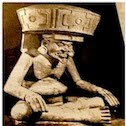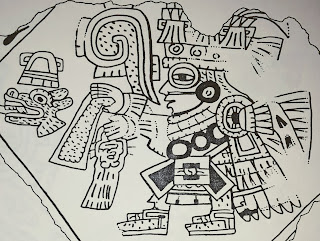Some of the Disciplines of the Teotihuacan University.
 |
| [10] A Surgeon on his way to a new patient.and [11] An inspector for water-controlled usage |
 |
[7] May be a choral group with acrobatics.
[8] A seller medicinal red wood for medical problems..
|
For Mexico, education for the men was and still is a major endeavor. Women have been added over the years and they have done an excellent job with archaeology and anthropology.
However, the Rabbit Patrol is a much needed service. A drunk on the street is not for one man to handle. Hard liquor can make a man stronger than an ox, even though he is a calm, weaker man when he is sober. So the Rabbit Control would call for help when needed as in the picture below: A drunken rip-roaring song telling the world, either he lost his great love, or his wife tossed him out because he was getting ornery. Or maybe he just tripped and fell and could not get up, so decided he would sing a song anyway.
 |
| The Rabbit Patrol with one calling for more help [Bottom, Left] |
The drawing comes from Atetelco, Teotihucan. The first time I saw this scenario was in a pre-1994 translation of the Codex Ramirez. The man on his back had curly blond hair; the inference having his heart cut out, as a sacrifice on an Aztec altar. An Aztec-scribe-prisoner making a statement? It seems to have been Independent Invention or just wishful thinking on the part of the scribe.
The next time I saw it in a book or in a magazine, in full color, was when an Aztec sacrifice was having his heart held up by the priest, and those holding the man down were about to toss him down the already bloody steps of the pyramid-temple. The temple, knife and blood was added but the layout was the same.
Mathematics
Addition and Subtraction
Bars and Dots
Math had to begin with the basics of Addition and Subtraction. when the process with bars and dots was completed, then the more complex math was used (as noted with teacher at the top pointing to a different type the students would be learning next.
A simple discipline as Botany and Agriculture needed counting skills is a land where fruit trees and corn, beans and other edibles abound. Water control and sluices were necessary part of such work.

Astronomy was more complex
Star measurements were made with forms similar to the Chinese Observatory structures at Beijing and a Jaipur, India. Star watching information then could be tracked anywhere in the world. Or even as directionals on land.









